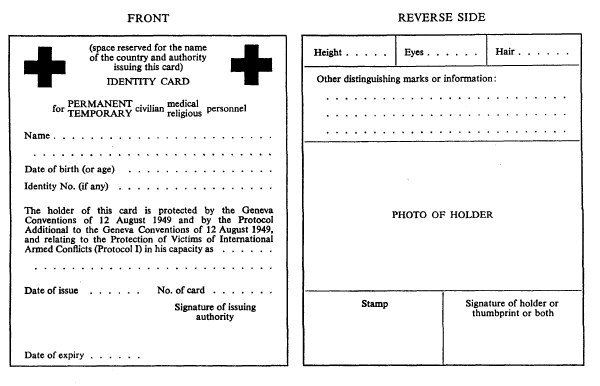Modifications etc. (not altering text)
C1Scheds. 5, 6, inserted (20.7.1998) by 1995 c. 27, ss. 6, 7(2); S.I. 1998/1505, art. 2
SCHEDULES
Section 7(1)
[F1SCHEDULE 7U.K.Protocol additional to the Geneva Conventions of 12 August 1949, and relating to the Adoption of an Additional Distinctive Emblem (Protocol III), 8 December 2005
Textual Amendments
F1Sch. 7 inserted (5.4.2010) by Geneva Conventions and United Nations Personnel (Protocols) Act 2009 (c. 6), ss. 1(8), 3(1), Schs.; S.I. 2009/2892, art. 2
PreambleU.K.
The High Contracting Parties,
Reaffirming the provisions of the Geneva Conventions of 12 August 1949 (in particular Articles 26, 38, 42 and 44 of the First Geneva Convention) and, where applicable, their Additional Protocols of 8 June 1977 (in particular Articles 18 and 38 of Additional Protocol I and Article 12 of Additional Protocol II), concerning the use of distinctive emblems,
Desiring to supplement the aforementioned provisions so as to enhance their protective value and universal character,
Noting that this Protocol is without prejudice to the recognized right of High Contracting Parties to continue to use the emblems they are using in conformity with their obligations under the Geneva Conventions and, where applicable, the Protocols additional thereto,
Recalling that the obligation to respect persons and objects protected by the Geneva Conventions and the Protocols additional thereto derives from their protected status under international law and is not dependent on use of the distinctive emblems, signs or signals,
Stressing that the distinctive emblems are not intended to have any religious, ethnic, racial, regional or political significance,
Emphasizing the importance of ensuring full respect for the obligations relating to the distinctive emblems recognized in the Geneva Conventions, and, where applicable, the Protocols additional thereto,
Recalling that Article 44 of the First Geneva Convention makes the distinction between the protective use and the indicative use of the distinctive emblems,
Recalling further that National Societies undertaking activities on the territory of another State must ensure that the emblems they intend to use within the framework of such activities may be used in the country where the activity takes place and in the country or countries of transit,
Recognizing the difficulties that certain States and National Societies may have with the use of the existing distinctive emblems,
Noting the determination of the International Committee of the Red Cross, the International Federation of Red Cross and Red Crescent Societies and the International Red Cross and Red Crescent Movement to retain their current names and emblems,
Have agreed on the following:
Article 1 — Respect for and scope of application of this ProtocolU.K.
1U.K.The High Contracting Parties undertake to respect and to ensure respect for this Protocol in all circumstances.
2U.K.This Protocol reaffirms and supplements the provisions of the four Geneva Conventions of 12 August 1949 (“the Geneva Conventions”) and, where applicable, of their two Additional Protocols of 8 June 1977 (“the 1977 Additional Protocols”) relating to the distinctive emblems, namely the red cross, the red crescent and the red lion and sun, and shall apply in the same situations as those referred to in these provisions.
Article 4 — International Committee of the Red Cross and International Federation of Red Cross and Red Crescent SocietiesU.K.
The International Committee of the Red Cross and the International Federation of Red Cross and Red Crescent Societies, and their duly authorized personnel, may use, in exceptional circumstances and to facilitate their work, the distinctive emblem referred to in Article 2 of this Protocol.
Article 5 — Missions under United Nations auspicesU.K.
The medical services and religious personnel participating in operations under the auspices of the United Nations may, with the agreement of participating States, use one of the distinctive emblems mentioned in Articles 1 and 2.
Article 7 — DisseminationU.K.
The High Contracting Parties undertake, in time of peace as in time of armed conflict, to disseminate this Protocol as widely as possible in their respective countries and, in particular, to include the study thereof in their programmes of military instruction and to encourage the study thereof by the civilian population, so that this instrument may become known to the armed forces and to the civilian population.
Article 8 — SignatureU.K.
This Protocol shall be open for signature by the Parties to the Geneva Conventions on the day of its adoption and will remain open for a period of twelve months.
Article 9 — RatificationU.K.
This Protocol shall be ratified as soon as possible. The instruments of ratification shall be deposited with the Swiss Federal Council, depositary of the Geneva Conventions and the 1977 Additional Protocols.
Article 10 — AccessionU.K.
This Protocol shall be open for accession by any Party to the Geneva Conventions which has not signed it. The instruments of accession shall be deposited with the depositary.
Article 15 — NotificationsU.K.
The depositary shall inform the High Contracting Parties as well as the Parties to the Geneva Conventions, whether or not they are signatories of this Protocol, of:
(a)signatures affixed to this Protocol and the deposit of instruments of ratification and accession under Articles 8, 9 and 10;
(b)the date of entry into force of this Protocol under Article 11 within ten days of said entry into force;
(c)communications received under Article 13;
(d)denunciations under Article 14.
Article 17 — Authentic textsU.K.
The original of this Protocol, of which the Arabic, Chinese, English, French, Russian and Spanish texts are equally authentic, shall be deposited with the depositary, which shall transmit certified true copies thereof to all the Parties to the Geneva Conventions.
(Article 2, paragraph 2 and Article 3, paragraph 1 of the Protocol)

